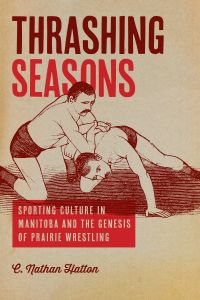Thrashing Seasons
Éditeur : University of Manitoba Press
ISBN numérique ePub: 9780887554957
Parution : 2016
Catégorisation :
Livres numériques /
Autre /
Autre /
Autre.
Formats disponibles
| Format | Qté. disp. | Prix* | Commander |
|---|---|---|---|
| Numérique ePub Protection filigrane*** |
Illimité | Prix : 24,99 $ |
*Les prix sont en dollars canadien. Taxes et frais de livraison en sus.
***Ce produit est protégé en vertu des droits d'auteurs.
Description
Horseback wrestling, catch-as-catch-can, glima; long before the advent of today’s WWE, forms of wrestling were practised by virtually every cultural group. C. Nathan Hatton’s Thrashing Seasons tells the story of wrestling in Manitoba from its earliest documented origins in the eighteenth century to the Great Depression.
Wrestling was never merely a sport: residents of Manitoba found meaning beyond the simple act of two people struggling for physical advantage on a mat, in a ring, or on a grassy field. Frequently controversial and often divisive, wrestling was nevertheless a popular and resilient cultural practice that proved adaptable to the rapidly changing social conditions in western Canada during its early boom period.
In addition to chronicling the colourful exploits of the many athletes who shaped wrestling’s early years, Hatton explores wrestling as a social phenomenon intimately bound up with debates around respectability, ethnicity, race, class, and idealized conceptions of masculinity. In doing so, Thrashing Seasons illuminates wrestling as a complex and socially significant cultural activity, one that has been virtually unexamined by Canadian historians looking at the nineteenth and early twentieth centuries.























